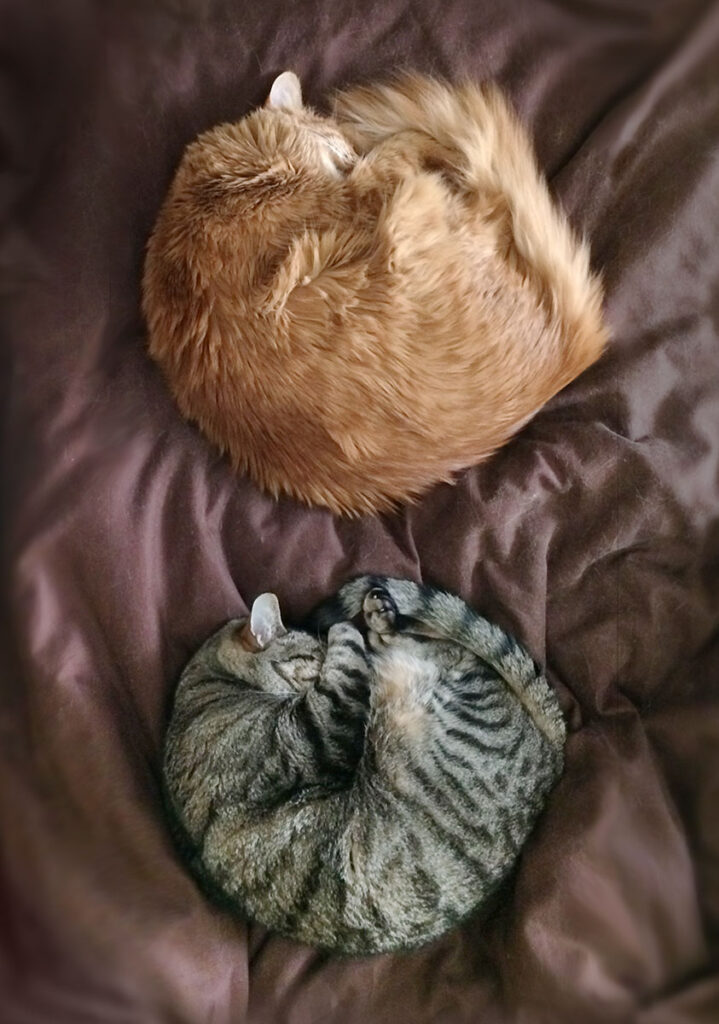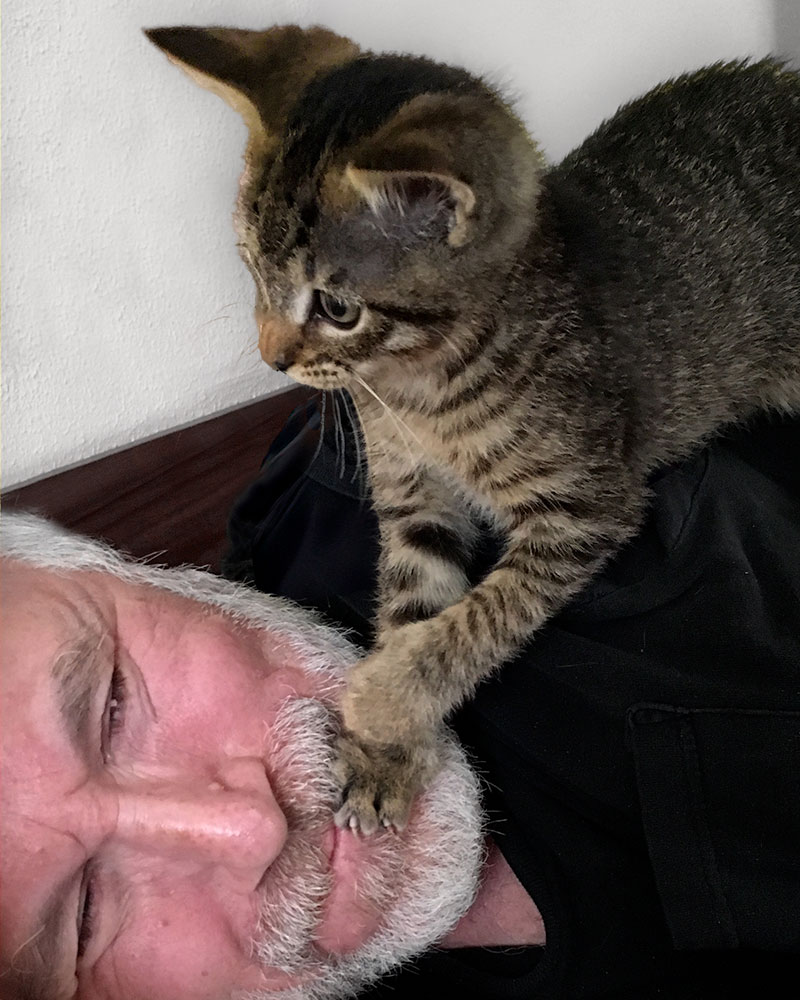Timmy, our fluffy orange Maine Coon mix, is an extortionist. When I sit down to have lunch, he’ll jump up on the table, saunter over to my plate, and say, “Nice sandwich you’ve got there. It would be a shame if anything happened to it.” Then, to show that he means business, he’ll poke it with his nose. I have to pay him off with a bowl of kibble if I want to have any peace.
Mary Beth, our gray-brown tabby, is a discriminating shopper. She’ll jump onto my crowded desk, stroll around examining the merchandise, find the object she wants to claim — perhaps a scrap of paper or a thumb drive — and then carry it off with the satisfaction of someone who has found a valuable antique in a flea market.
If you find these cameos charming, then you’re clearly an ardent cat person. If you don’t, I can’t blame you. I’m a cat person, but the only cats I’m really interested in are my own. Other people’s cats are just cats. Sure, they may do something adorable in a Facebook photo, like snuggling up in a blanket or chasing a toy, but that’s just generic cuteness, a defining aspect of felinity. My cats have multilayered personalities and complex psychological profiles. They’re also prettier than anyone else’s cats.
Jon Carroll used to write a daily column for the San Francisco Chronicle in which he’d interweave stories of his daily life with unique insights into politics and culture. He had a devoted following, myself among them. (I’ve recently come to realize that I’ve unconsciously been emulating Carroll in my approach to writing this blog.) Occasionally, he’d choose to write about the latest doings of his cats, Archie and Bucket (and later, Pancho). He didn’t necessarily have anything profound to say about them; he just thought that the activities of his cats were fascinating and assumed that other people would, too. It turned out that they didn’t, or at least a vocal minority of his readership didn’t. He got so many complaints about his Archie and Bucket stories that he ended up having to preface each such column with a disclaimer like “This is a cat column. If you have an objection to reading about cats, stop here.”
Several of my earlier blog posts have begun with stories about my cats, but the cats later turned out to be metaphors for something else. Taking a page from Jon Carroll, I should warn you that there are no metaphors coming up; I’m really just writing about cats this time.
I wasn’t always a cat person. I grew up without pets, because my mother considered animals — particularly cats — to be nasty and filthy. (When my parents came to visit Debra and me after we’d adopted Brook, our first cat, my mother said, “I can’t understand why you’d allow wildlife in your house.”) The first extended exposure I had to a domestic animal was the summer after I graduated from college, when some friends and I sublet a small house that came with a cat named Motley. Motley was a mostly-outdoor cat who would drop by only now and then to pick up his mail, but when he was around, he tended to act as if he owned the place (which, in a sense, he did). I would sometimes wake up in the morning to find him standing on me, and I was surprised to find out that I liked the pressure of his little padded feet on my belly.
Like most other recent graduates, I moved around for a few years from house to house and apartment to apartment, and I gradually got to know other cats along the way. Although I was never one to set long-term goals, I did develop a fantasy of the ideal domestic life: feeling securely settled enough in a place to get a piano and a cat.
That time came years later, shortly after Debra and I moved from New Jersey to California and rented a house in a friendly Oakland neighborhood. Debra, who had even less experience with animals than I had, was hesitant, but we decided to adopt Brook, a month-old kitten — because who doesn’t love kittens? — and assume that Debra would grow attached to her by the time she became a cat. The plan worked, and now Debra is a cat maven who volunteers at three animal shelters. (We eventually got a piano as well.)
As for me, slightly more than twenty years ago, I started studying a form of therapeutic bodywork called Breema. One of Breema’s fundamental principles is that the recipient’s body will be relaxed and comfortable only if the practitioner’s body is relaxed and comfortable. If I’m touching someone’s body with the intention of making them feel better, simply having that intention works against my aim of being comfortable. As a Breema practitioner, the only way I can help someone is by not trying to help them. That was a difficult lesson to learn.
The breakthrough came when I realized how much I could learn from Brook, our cat. Brookie not only slept with me, but was in physical contact with me most of the time — draped over my shoulders when I was sitting at my desk, curled on my lap when I was watching TV, kneading my belly when I was lying down. I came to realize that she was always doing Breema. She was never trying to relax me; she was making herself comfortable, letting her body adapt to mine, and the result was naturally soothing to me. Now, whenever I do Breema, I try to remember how a cat would do it.
Timmy, the cat for whom I currently serve as a bed, likes to drape himself over my left leg with his head resting on my thigh. Each of us sleeps better when the other is there. Nearly every afternoon while I’m working at my desk, Timmy comes over, bumps his head against my shin, and trots toward the bedroom. That’s his sign that it’s time for us to take a nap together. If I ignore him and keep working, he’ll come back and bump me with his head again. Eventually, I’ll give in and follow him to the bedroom. It’s hard to say no to taking a nap, especially with a warm cat draped snugly over your leg.



Recent Comments